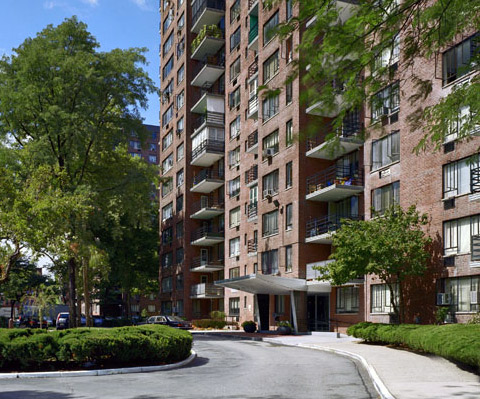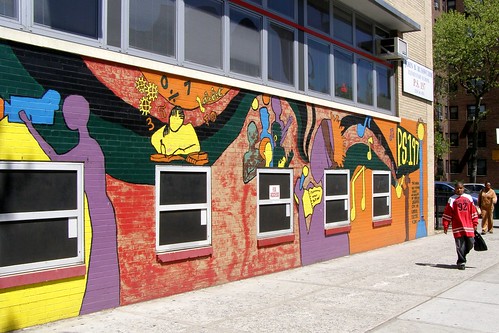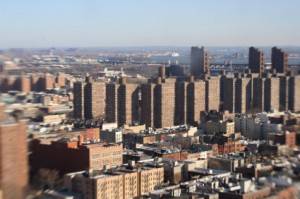It was in East Harlem where I experienced a cultural exchange with primarily the Puerto Rican community.
Tynesha, a client, who happens to be African-American, was in my office for some employment counseling, when suddenly the conversation shifted to a topic directed at me. “So you are Black,” she says. I shrugged and said, “the last time I looked in the mirror I was, why?” She says because you got all this Latin stuff on your wall. I then pointed out pictures of Booker T Washington, which was on my office door, and John Coltrane and Muhammad, which were on my wall. Her response was, “yes but those pictures are overwhelmed by your pictures from Perú, Cuba, and Ecuador, and these other Latin countries.” Well, I have to admit that I've always had an interest in Latino cultures, which is why I blog, African American-Latino World.

The Lenox Terrace on New York's 5th Avenue in Harlem, where I lived as a child, was the dividing line between East and West Harlem.
It all started when I was a little boy living on the dividing line between East and West Harlem in New York City. East Harlem contains a large Spanish-speaking population, mostly Puerto Rican. I began noticing some cultural exchange between some African-Americans and Puerto Ricans in the community, mainly New York born Puerto Ricans (Nuyoricans). Even I started picking up on some Spanish at the age of 10. We went to the same schools and community centers. Some of us dated each other.
In the spring and summer months, it was common to see African-American and Puerto Rican musicians in Marcus Garvey Park, across the street from my old Junior High School, James Fenimore Cooper, in East Harlem. Guys brought their conga drums, bongos, flutes, and other percussion and wind instruments to jam to jazz and Latin jazz tunes. By the time I became a teenager, I felt myself getting culturally turned out! Walter, an African-American school friend came to my house and noticed my large collection of salsa and Latin jazz albums in my room. Walter just chuckled, scratched his head, and told me that I was turning into a Puerto Rican.

My old elementary school, P.S. 197-Manhattan, also on 5th Avenue; dividing East and West Harlem.
Even people in the Spanish-speaking countries that I've visited have assumed that I too am Latino. In Ecuador, a cab driver asked me, “es usted caribeño?” In other words, am I Puerto Rican, Cuban, or Dominican. When I later crossed the border from Ecuador into Perú, I was stopped by the police three times because they thought I was an illegal alien from either Ecuador or Colombia. One cop, who figured my American passport might be fake, started asking me a lot of intense questions. I said to myself, my Spanish can't be this good? Why is this cop tripping?
When he first approached me I snapped at him in Peruvian slang, despacio, mi español es monse--slow down, my Spanish is whack! When the officer was finally done interrogating me, I said to him, sarcastically, gracias por la práctica en mi español (thank you for helping me practice my Spanish). The officer responded with, ¡Ya!, meaning yeah, yeah, yeah as he walked dejectedly back to his patrol car. I think he think he was looking for a bribe.
What Walter, who said that I'm turning into a Puerto Rican, did not realize, and neither did I at the time, was that this hot Latin music that was turning so many people on, including me, not only has Spanish roots, but African roots as well.What my client, Tynesha, don't realize is that during the slave trade, the overwhelming majority of Africans went to Latin-America, not the U.S.
I was working on a term paper for my African-American studies class at the Arturo Alfonso Schomburg Center for Research and Black Culture in Harlem, which by the way, is named in honor of a Black Puerto Rican, There, I learned about the African presence and influence on Latin-American cultures from Mexico and the Caribbean, all the way down through Argentina.

The Schomburg Center for Research & Black Culture, a branch of the New York Public LibraryHowever, it wasn't until late into my adulthood when I decided to adopt Spanish as my second language. My late Mexican-American friend, Yolanda Gutierrez, encouraged me to learn the culture as well as the language. As badly as I wanted to take Yolanda's advice, I was confused. There must be at least 18, 19, or 20 different Latin American cultures. Exactly where was I supposed to begin?
Well, I took the easy way out. I started reading about the Latin American cultures where Africans had an influence on the music I enjoyed most; son-montuno from Cuba, bachata from the Dominican Republic, and jarocho from Mexico. Then I expanded to tambor from Venezuela, saya from Bolivia, and marimba from Ecuador. I began traveling to selected Latin American countries to explore their black experience. For example, in Colombia, I visited a landmark African village where their descendants freed themselves, Nat Turner style, from Spanish rule more than 200 years before the rest of the nation of Colombia won their independence.It was my love for salsa and Afro-Cuban music that reignited my desire to learn to speak Spanish.
As of today, I've visited 30 Latin American cities and towns in 10 countries, including Miami, which I consider to be an honorary Latin-American town where people, especially Cubans, are in-your-face proud of their language and culture. I remember walking into Cuban restaurant, and the cook asked me in broken English, “can I help you?” When I told her in Spanish that it was OK to speak to Spanish, she, her co-worker, and a even a customer were so cheered that they made me feel right at home. I don't always get that reaction when I'm in New York where I grew up, San Francisco where I work, or Oakland, where I live.
My next trip includes Honduras and Guatemala where I want some exposure to the descendants of Africans slaves who revolted against the British, escaped, and found refuge among indigenous people; then I'll be going to Chile, where the City of Arica has a historic African presence. The way it looks, I'm going to continue learning the Spanish language and various Latin-American cultures, particularly those of African ancestry until I'm on my death bed. Thus, my blog, African American-Latino Word continues.


Bill, as a fellow east coast transplant living in the bay area, I wanted to thank you for this post. Much like you, I got into learning spanish and about Latin cultures through friends in my neighborhood.
ReplyDeleteI'm actually half latino and unfortunately that part of my heritage wasn't passed on as much as I would have liked, so I'm making up for lost time travelling and learning about the different cultures. Good luck to you and keep blogging.
Hi Bill,
ReplyDeleteI've been enjoying your blog. I had always dreamed about some serious travel, Latin America - alas fate has broght me to the other side of the world. Don't have many opportunities to use my Spanish in the Middle East!
I had to to stop at the photo you posted of Lenox Terrace - I know the building well! I had an uncle that lived there until the late '90s and I used to hang out there sometimes. Small world, as they say.
Keep up the good work!
Yrs, Expat, this is a small world. I really appreciate your visits to this blog and your comment.
DeleteBill